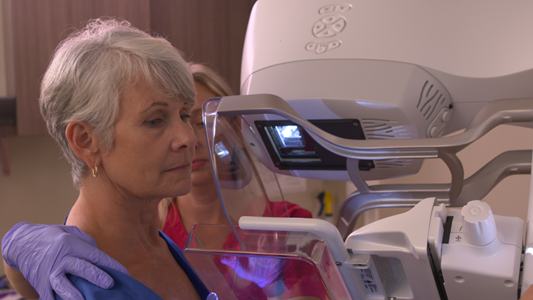Contrast Mammography generates a quick and confident diagnosis—less than seven minutes after the first inconclusive exam[1] But which patients stand to gain the most from it?
When a traditional mammogram yields an inconclusive result, it can trigger patient anxiety—exacerbated when patients have to wait to be seen for further examination. For certain women at high risk for breast cancer, a screening breast MRI can also be recommended in addition to a yearly mammogram.
MRI is highly recommended imaging exam for breast cancer. However, the demand for use of the technology can make it challenging to schedule right away and could lead to patient not following-up on care. Due to demand, available appointments, cost, and patient challenges like claustrophobia, fear of loud noises, and contra-indication, clinicians may not opt to use MRI —especially for certain populations of patients, including existing breast cancer patients as well as those at middle- or high-risk for the disease.
The industry has developed another proven and viable alternative for breast cancer diagnosis in contrast-enhanced mammography (CEM or CESM), also known as contrast mammography (CM). This technology is a straightforward alternative diagnostic breast exam combines an iodine contrast medium (this iodinated contrast is similar to a contrast medium that can be used in computed tomography)[2], with conventional mammography for a detailed look at blood flow. It can result in increased diagnostic confidence for healthcare professionals by helping localize known or suspicious lesions with the iodine contrast. Further it can provide high specificity for low false-positives and help prevent unnecessary exams,3 while potentially as sensitive as MRI in evaluating the extent of disease in newly diagnosed breast cancers.[3]
Benefits to the Patient Experience
Patient experience is also an important factor when comparing and deciding on which of these modalities is preferable with respect to their benefits. Aside from the image itself, CEM offers benefits in that it can generate a quick and confident diagnosis—in less than seven minutes.1 Some patients have found that shorter examination time and globally less taxing procedure makes CEM much better tolerated by patients.[4] Furthermore, the same-day, same-team, same-place workup helps address increased patient anxiety between first and secondary imaging appointments.
Contrast mammography can transform a patients’ experience due to faster procedure time, greater comfort, lower noise level and lower rates of anxiety.[5] Other impacts include the ease with which a CEM exam can be conducted. Contrast Mammography can play a role among patients with contraindications for MRI, such as those with claustrophobia.[6]
Factoring in Clinical and Operational Efficiencies
Above all, research has continuously pointed to CEM’s utility and optimal performance when conducted with traditional mammography.[7] Research indicates a 53% reduction in equipment costs in addition to 59% reduced staffing costs compared to breast MRI.[8]
In the future, the combination of clinical and financial benefits could even make the case for CEM as a frontline screener.[9] Could we have a day where CEM becomes the predominant screening method for everyone? Time will tell, but as the technology continues to advance, that future could be closer than ever.
RELATED CONTENT
For more information, best practices, and guidelines, explore GE HealthCare’s mammography resources, including the SenoBright, Serena Bright and Pristina Bright web pages..
References
[1] GE HealthCare’s SenoBright Contrast-Enhanced Spectral Mammography. GE HealthCare. https://www.youtube.com/watch?v=B3-BHPs1kTs. Accessed Sep. 25, 2019.
[2] Contrast-enhanced Mammography: How Does It Work? https://pubs.rsna.org/doi/full/10.1148/rg.2021200167#:~:text=Abstract,and%20assessment%20of%20tumor%20neovascularity.
[3] 510(k) K103485
[4] The emerging role of contrast-enhanced mammography: Andrea Cozzi, corresponding author Simone Schiaffino, and Francesco Sardanelli Quant Imaging Med Surg. 2019 Dec; 9(12): 2012–2018 https://www.ncbi.nlm.nih.gov/pmc/articles/PMC6942965/
[5] Hobbs et al., Contrast-enhanced spectral mammography (CESM) and contrast enhanced MRI (CEMRI): Patient preferences and tolerance, J Med Imaging Radiat Oncol. 2015 https://pubmed.ncbi.nlm.nih.gov/25900704/
[6] Contrast-enhanced spectral mammography (CEM) and contrast enhanced MRI (CEMRI): Patient preferences and tolerance, Journal of Medical Imaging and Radiation Oncology, https://onlinelibrary.wiley.com/doi/full/10.1111/1754-9485.12296 . Accessed Oct. 18, 2019.
[7] Contrast-enhanced Mammography: Current Applications and Future Directions. RSNA Radiographics. https://pubs.rsna.org/doi/full/10.1148/rg.2019190079 Accessed: Nov. 7, 2019.
[8] Patel et al., Potential Cost Savings of Contrast-Enhanced Digital Mammography, AJR Am J Roentgenology. https://www.ajronline.org/doi/abs/10.2214/AJR.16.17239 2017

